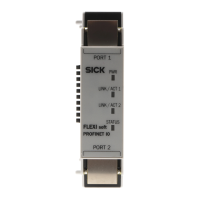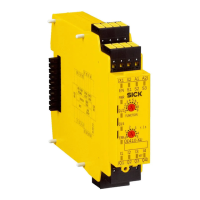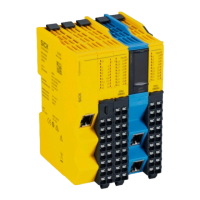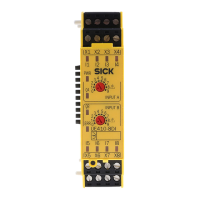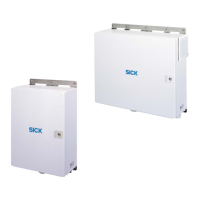15 Glossary
AWG American Wire Gage: standardization and classification of wires
and c
ables according to type, diameter, etc.
CCF Common cause failure. Failures of various units due to a single
event, whereby these failures do not cause each other.
Control input A control input receives signals, e.g. from the machine or from
t
he control. Use of control inputs is how the protective device
receives information about the conditions at the machine, e.g., if
there is a change of operating mode. If the protective device is
configured appropriately, it will activate a different monitoring case
after receiving a new control input.
The control input information must be transmitted reliably. Gener‐
ally, at least 2 separate channels are used to do this.
Depending on the device, a control input can be realized as a
static control input or a dynamic control input.
Dangerous state A dangerous state is a status of the machine or facility, where
people ma
y be injured. Protective devices prevent this risk if the
machine is operated within its intended use.
The figures in this document always show the dangerous state of
the machine as movement of a machine part. In practice, there
are different dangerous states, such as:
•
Machine movements
•
Electrical parts
•
Visible and invisible beam
•
A combination of multiple hazards
EDM External device monitoring
EFI-pro EFI-pro
11
)
is an Ethernet-based network for general and safety-
related data communication.
EFI-pro allows for easy device identification, addressing, configura‐
tion, and diagnostics.
Devices can exchange data via EFI-pro, such as control signals,
safety-related shut-off signals, and diagnostics data.
An EFI-pro network can have various structures (topologies), e.g.,
with cables running from one central device to all the others (star
topology) or with cables running from one device to the next (line
topology). Different topologies can be combined within one EFI-pro
network to form a hybrid topology.
ESD Electrostatic discharge
ESPE Electro-sensitive protective device
EtherCAT EtherCAT® (Ethernet for Control Automation Technology) is an
E
thernet-based network used in industrial automation.
With the Safety over EtherCAT® (FSoE, FailSafe over EtherCAT)
protocol extension, EtherCAT® is also suitable for safety-related
data communication.
EtherNet/IP EtherNet/IP™ (EtherNet Industrial Protocol) is an Ethernet-based
ne
twork used in industrial automation.
EtherNet/IP™ implements the CIP™ (Common Industrial Protocol)
based on the Ethernet and TCP/IP protocol family.
EtherNet/IP™ with the CIP Safety™ protocol extension is also suit‐
able for safety-related data communication.
11)
Enhanced F
unction Interface-pro based on EtherNet/IP™ – CIP Safety™.
GLOSSARY 15
8012478/1IG6/2023-02-24 | SICK O P E R A T I N G I N S T R U C T I O N S | Flexi Soft Modular Safety Controller
185
Subject to change without notice

